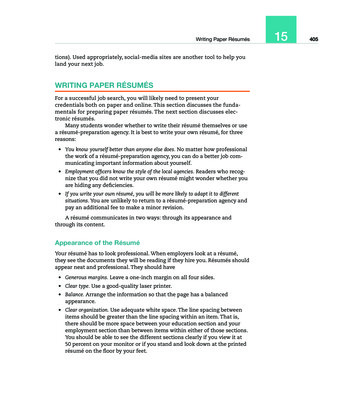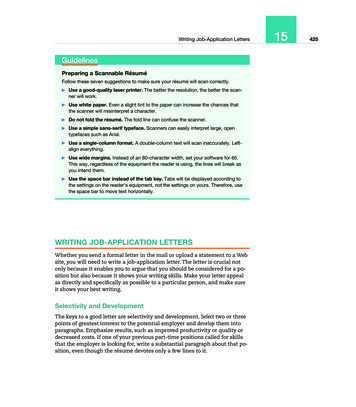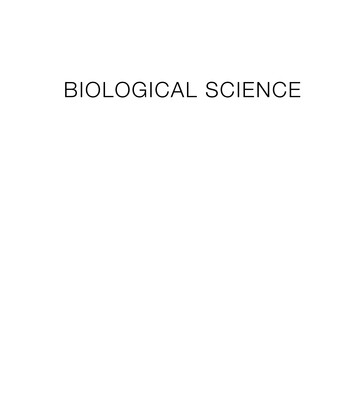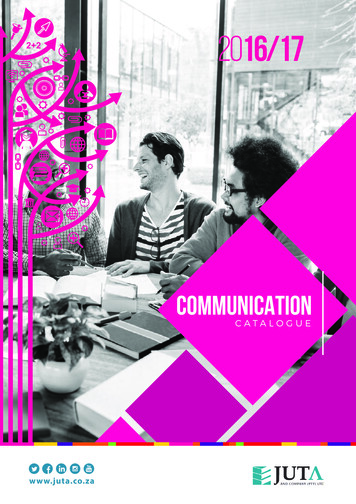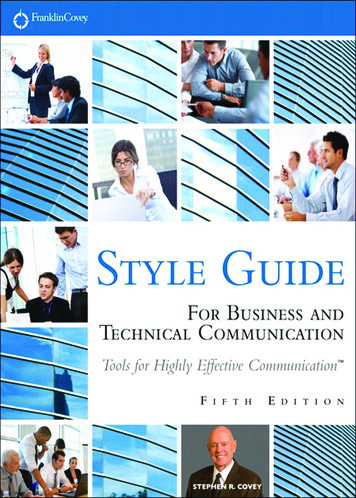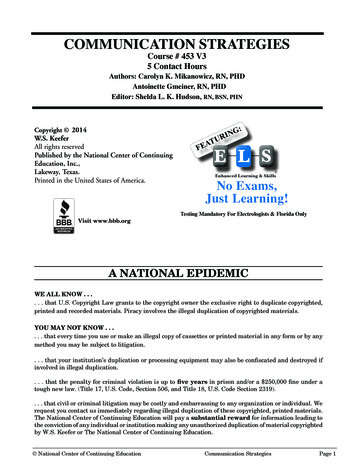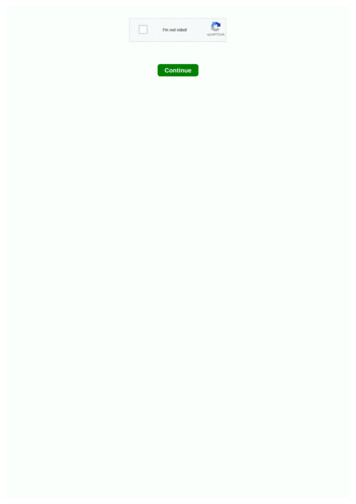
Transcription
Continue
Technical communication 11th edition markel pdf free download
More way to learn with LaunchPad for Technical Communicationmacmillanhighered.com/techcomm11e, where students learn technical communication, includes cross-references to LaunchPad, an online course area that includes document analysis activities, cases, tutorials, quizs that provide instantfeedback, and more. If your book didn't come packaged with an access code, you can purchase macmillanhighered.com/techcomm11e.In LaunchPad for Technical Communication from LaunchPad, which is not available. Nalysis activity based on multimodal sample documents, including videoinstructions and interactive visual reports Downloadable versions of useful forms discussed in text L earningCurve: adaptable to help you focus on the topics you need the most help with, Game-like application real-case scenarios built around common workplace documents a test bank withquiznatics and additional situations and exercises for each chapter digital composition, technology tips, tutorials and documentation teamwriting v ideo-based modules two full-length ebooks: Document-Based Situations for Technical Communications, Roger Munger's Second Edition and JoannaWolfe's Full List of Team Writing LaunchPad content see the next two pages. LaunchPad forTechnical Communication is defined throughout text with an icon inside LaunchPad materials. To access the book's LaunchPad, go to the online delivery Document-based cases that were previously available at the end of each chapter, where you can recognize each scenario, download and work with related documents, and access assignment questions in a single space. CASE 1: Using Measuresof Excellence When Evaluating a Case 11: Flyer Design Resume CASE 12: Creating Appropriate Graphics to Accompany ACASE 2: Ethics for Requiring Students to Subside a Report PlaGiarism-Detection Service CASE 13: Reviewing the Document for a New AudienceCASE 3: Understanding Whyrevision software can't revise and edit your document CASE 14: Creating and Maintaining a Professional Microblogging AccountCASE 4: Meeting a Team Member's Scheduling Issues CASE 15: Identifying the Best Job Search SitesCASE 5: Focusing on an Audience's Needs and Interests CASE 16:Reviewing a Short OfferCASE 6: Reviewing the Survey CASE17: Writing Guidelines on Using Agendas for MeetingsCASE 7: Organizing a Document for Clarity and Diplomacy CASE 18: Analyzing Decision MatricesCASE 8 : Analysis of The Persuasiveness of a Website CASE 19 : Introducing theScientific Method through LabCASE 9: Highlighting Important Information in the Technical Report Description CASE 20: Choosing an Environment to Present InstructionsCASE 10: Revising a Document for Nonnative Speakers and Translation CASE 21: Request and Support Structure for PresentationGraphs WORKING with FORMSDownload and various useful forms select the text. Work-Timing Form (Part 4) Audience Profile Page (Part 5)Team-Member Evaluation Form (Part 4) Oral Presentation Evaluation Form (Part 21)Self-Assessment Form (Part 4)LEARNINGCURVE Basic skills for multilingualauthors with LearningCurve, a funadaptive exam program that welcomes you where you are and gives you the extra support you need when you need it, as well as the material covered in the first ten sections of the Text. Understanding Technical Communication Environment Articles and Names forMultilingual Authors (Covered (Chapter 1: Part 1–4) Annex D: Guidelines for Multilingual Authors)Analyzing Your Audience and Purpose (Covering Part 5) Presems for Multilingual Authors (Annex D: Guidelines for Multilingual Authors)Researching Your Subject (Covering Chapter 6) Sentence Structure forMultilingual Authors (CoveringOrganizing and Highlighting Information (Additional Section D Covering Chapter D : Guidelines for Multilingual Authors) 7 and 9) Verbs for Multilingual Authors (Covering Additional Part D:Persuasive Communication for Multilingual Authors (Covering Chapter 8) for MultilingualAuthors Guidelines)Writing Accurate and Effective Sentences (Covering Part 10)DOCUMENT ANALYSIS ACTIVITIES Combine real multimedia documents that leverage digital technologies in exciting new ways and respond to prompts to help you analyze them. Interactive Graphic: Tom Giratikanon andDavid Schutz, Mechanism Description Using Interactive Graphics: How Hard The Wind Will Hit Your Region, and the Hybridcenter.org and The Union of Concerned Scientists, (Part 12) Hybrids Under Title (Part 2) (Part 20)Online Portfolio: Blane C. Holden's Description of the Online Portfolio ProcessUsing Video Animation: North Carolina (Part 15) Department of Transportation (NCDOT), Different Diamond Exchange Visualization (Part 20)Pre Presentation : Andrew Washuta, Marketing Proposal Presentation (Part 16) Instructions for Using Video Demonstration: PartSelect, Dryer Repair—Replacement of the High Limit Thermostat Presented as a Website (Part 20)Report: United States Geological Survey, High Plains Water Level Monitoring Operating Instructions Using Video Screen Capture: TechSmith, Jing (Part 17) Learning Center: Informative report provided with interactiveinstructions using a Combination of Video Screening : Matthew C. Hansen and Hansen. , University of and Screen Capture: Texas Tech University Multiple Maryland, Google, USGS and NASA, Global Forest Literacy Lab (MuLL), Recording Audio in the Field Using a Change Interactive Map (Chapter 17)iTalk (Chapter 20)Recommendations Presented in a Audio Podcast: Centers Definition Using Video Animation: ABC News, What for Disease Control, Influenza 2010–2011 , ACIP Vaccination Cloud? (Chapter 20) Recommendations (Part 18)TEAM WRITING MODULESThis modules were built around fiveshort videos of the real team focusing on the role of written communication in teamwork. They will teach you how to use written documents to manage a team by producing task schedules, minutes, leases and other important documents, and will also provide models for working on large collaborativedocuments. Collaboration Methods in Team 1 Responses and Results for Team 4 Responses and Results for Team 1 Rules of Collaboration in Team 2 Conflict Management Creating Meeting Minutes for Team 3 Creating Team 5 Responses and Results for Team 5 Team 2 Team 4 Responses Team2Conflict Creating a Task Schedule for Management and Results for Teams 3 Self-Promotion in Teams 1 and 3 and Self-Depresenting Speech 3 and 4TUTORIALSEnging tutorials show useful tools and tips for building your projects, as well as the documentation process to cite the resources you use inMLA and APA style. DIGITAL WRITING TRAININGS Using Wikis for Collaboration Work (Part 4)Cross-Platform Word Processing with CloudOn, Using Quip and Collaboration Software (Part 4) Reading Corrections for Format Consistency (Part 11) More (Part 3)Monitoring Resources with Evernote andZotero (Part 6) DOCUMENT TRAININGSPhoto Editing Basics With GIMP (Part 12) Quoting an APA-Style Database (Creating Your Professional Brand with Appennising B:LinkedIn, Twitter and Documenting Resources) More (Part 15) How to Cite an APA-Style Website (Additional B:PowerPoint andCreating Presentations with Prezi (Part 21)Recording and Editing Audio with Audacity (Part 2 1) Documenting Resources) Quoting an Article in MLA Style (Additional B:Digital TIPS TRAININGs Outline (Part 3) Documenting Resources)Creating Styles and Templates (Part 3) Quoting a Book in an MLAStyle (Appasery B :Planning Meetings Online (Part 4)Review of Collaboration Documents (Part 4) Documentation Resources)Including Tracked Changes (Part 4) How to Cite a Database in the MLA Style (Additional B:Holding Online Meetings (Part 4) Documentation Resources) How to Refer to an MLAStyle Website (Annex B: Documenting Resources)ELEVEN TECHNICALTH EDITIONCOMMUNICATION BedMike MarkelBoise State Universityford/St. Martin's #PTUPO t /FX:PSL Bedford/St. Martin'sVice President, Editorial, Macmillan Higher Education Humanities: Edwin HillEditorial Director of Englishand Music: Karen S. HenryPublisher for Business and Technical Writing: Leasa Burtonexecutive Editor for Business and Technical Writing: Molly ParkeAssociate Developmental Editor: Regina TavaniEd Assistant: Brenna CleelandPublishing Services Manager: Andrea CavaSenior Production Supervisor:Steven CestaroSenior Marketing Manager: Christina SheaProject Management: Lifland et al., BookmakersDirector of Rights and Permissions : Hilary NewmanSenior Artistic Director : Anna PalchikText Design: Maureen McCutcheon DesignCover Design: William BoardmanCover and Title Page JohnLund/Getty ImagesComposition: Graphic World, Inc.Printing and Binding: RR Donnelley and SonsCopyright 2015, 2012, 2010, 2007 Bedford/St. Martin'sAll rights reserved. No part of this book may be reproduced, stored in a unrecoupation process or transmitted in any form or in any way, electronic,mechanical, photocopying, registration or otherwise, except where explicitly permitted by applicable copyright statutes or permitted in writing by the Publisher.109876f edcbaFor information, write: Bedford/St. Martin's, 75 Arlington Street, Boston, MA 02116 (617-399-4000)ISBN 978-1-319-088088AcknowledgmentsAcknowledgments and copyrights appear on the same page as the texts and images they cover; these notices and copyrights form an extension of the copyright page. Any reproduction of these elections without the written permission of the copyright owner is a violation of the law.Communications distributed outside North America by PALGRAVE MACMILLANHoundmills, Basingstoke, Hampshire RG21 6XSPreface for InstructorsTECHNICAL COMMUNICATION always include collaboration. A writer who needed to produce an instruction manual for a new software package wouldhave seemed to have interviewed the engineer who wrote the code. The company also gathered a focus group to find out what users like and dislike about the prototype of the software. But now, there are more comments than ever between those who produce white paper-uments and those who consumethem. Typically, this interaction goes both way. Using social media and new technologies, technical communica-tors can collaborate with its audiences at every step of the communication processor. And thanks to online publishing, viewers contribute to the development of technical documents even afterpubing, asking and answering questions, revising existing information and offering new information. The types of documents that technical communicaters routinely produce have also changed. Microblogging posts, contributions to discussion boards and wikis, and status updates on a LinkedIn profile(once the raw materi-als of longer and more official documents) are now routinely used to ensure the unity of important messages. Despite these changes, the basics of technical communication are as important as always. An inaccession in a microblogging that forwards a project update is as big aproblem as an inac-curacy in a traditional progress report. And while we are living and working in the Age of Inan, which values shortness and quick turnaround, some information can only be easily communicated with longer and more detailed documents that are always at the heart of technicalcommunication. I revised this new edition of Technical Communications to help students understand how to communicate effectively in the fast-paced, highly collaborative world in which they will work. Employers never valued their means of communication as much as they did. I'm going to take them todayand for good reason. Today's profes-sionals need to communicate with more individuals more often, faster, more accurately and more often than ever before. This book will help prepare stu-dents in their courses and careers. In this Release, vPreface Eleventh Edition for New Instructorsvi recasts the mostpersistent features of text in the context of today's professional environment. Chapter 1, which has been revised extensively in light of the input of other technical communication instructors, provides the basis for the new focus of the text. I have updated and expanded the scope of the topics andtechnologies most relevant to the technical communika-tion process; In fact, I completely eliminated Section 22 because its subjects were integrated into many sections throughout the text. The tracker-related section includes an extended introduction that preparses students, considering viewers otherthan their instructors for the first time. In addition, this section offers techniques for analyzing social media data to better understand these audiences. The correspondence section now contains instructions on how to represent its organization in a microblogging. The section on definitions, descriptions, andinstructions covers the new role of discussion boards, wikis, and videos in disseminating information. Sample documents updated both in printed text and online provide opportunities for students to analyze the types of documents they need to produce or contribute, such as a municipal government appthat allows residents to report infrastructure issues directly on their phones, and an interactive map of global forest changes that allow dif-ferent audiences to customize their viewing experiences to get the sensitive information they need. The new edition communicates in new ways, in keeping with itspromise to serve as a model of the principles it teaches. Online resources tagged with an icon in text are available on LaunchPad, a customizable online course space, including a full ebook that can be packaged for free with new copies of text. Cases are now available on LaunchPad so students caneasily download and work with relevant documents. Tutori-als offers tools for multimodal composition, teaches useful technology tips and offers another learning documents. Learning Adaptive testing activities covering two decades help students master and practice concepts in a new, personalized way.LearningCurve activi- links for multilingual writers and video-based team writing modules that help students learn collaborative writing skills are also available here. LaunchPad also features two full-length ebooks: Document-Based Cases for Technical Communication, Roger Munger's Second Edition, andJoanna Wolfe's Team Writ-ing. Finally, instructors can access various instructor resources here and test bank with multiple choice, true/false and short-answer questions for each section. The following table describes the updates to each section in Eleventh Edition. Introduction to The ForewordviiCHAPTER FOR Instructors New focus on continuous collaboration between technical communicators and stakeholdersCommunication t Discussion of challenges related to the production and how to make technical communication2 Meet themWriting Technical t LearningCurve: Understanding theTechnical Communication Environment, coveringDocuments Chapters 1–4Chapter 4Writing Collaboratively t Discussion of ethical and legal issues related to social media, including guidelines for ethically using social media in the workplaceChapter 5 Analyzing Your Push Audience t Document AnalysisActivity : Social Media and Purpose t LearningCurve Offering Guidelines for Its Use: Understanding the Technical Communication Environment, EncompassingChapter 6 Part 1–4Seeing Yourselves t Advice on choosing the best digital writing tool for a projectChapter 7 t Document Analysis Activity:Identifying the Strengths and Weaknesses of a TradeInformation Template Editing Your Code TemplateChapter 8 t Tutorials on cross-Platform word processing and outline creation , styles andCommunicatingPersuasively templatesChapter 9 t LearningCurve: Understanding the Technical CommunicationEnvironment, Understanding Important Information Sections 1–4Chapter 10Writing and t Tutorials on planning and online execution, reviewing collaborative documents, Effective Sentences containing tracked changes, using wikis for collaborative work and using collaboration software t LearningCurve:Understanding the Technical Communication Environment, Chapter 1-4 t A new, more detailed introduction to the role of the audience and purpose t Recommendations on using social media data in audience analysis t Status : Focusing on an Audience's Needs and Interests t LearningCurve: AnalyzingYour Audience and Purpose t LearningCurve: Research on Your Subject Document Analysis Activity: Using Multiple Organizational Patterns in infographic t LearningCurve: Editing and Highlighting Information, Chapter 7 and 9 : Analyzing the Persuasiveness of a Website t LearningCurve: Communicatingconvincingly New focus on highlighting important information at various document levels t Status: Highlighting Important Information in a Technical Statement t LearningCurve: Editing and Highlighting Information covering Sections 7 and 9 Correct sentences carried from Additional C t LearningCurve:Writing Accurate and Effective Sentences for Instructors PART WHAT NEW Part 11 About designing documents for mobile screens Print and t Recommendations Online Documents t For a tutorial format consistency about correction Chapter 12 Graphics creation t Discussion of infographics t DocumentAnalysis Activity: Interactive Graphics Part 14 t Photos editing tutorial Correspondence Writing Part 15 t Instructions for representing your organization in a microblog : Establishing and Maintaining a Professional Microblogging Account Materials t Recommendations on building and using a professionalbrand Part 16 t Guidelines on creating and using a professional brand LinkedIn profile Writing Offers t Tutorial on creating a professional brand Part 17 t Document Analysis Activity: Blane C. Holden's Online Portfolio Writing Information t Status: Determining the Best of The Best Job Search Sites t Sampleinternal offer : Tablet Study Part 18 t Document Analysis Activity at Rawlings Regional Medical Center: Marketing Recommendation Presentation Writing Recommendation Reports t Sample progress report: Tablet Study Part 19 t Document Analysis Activity at Rawlings Regional Medical Center: HighPlains Water Level Monitoring Study Writing Laboratory Reports t Document Analysis Activity: Global Forest Change Interactive Map Part 20 Writing Definitions, t Sample recommendation report : Tablet Study Descriptions at Rawlings Regional Medical Center , and t Document Analysis Activity: Influenza2010–2011: ACIP Vaccine Recommendations Instructions t Moved from Section 18 to ensure that three sections using the sample report package (Tablet Part 21 Study at Rawlings Regional Medical Center) appear sequentially t Discussion about the role of social media in the dissemination of teachinginformation t Teaching videos t Document Analysis Activity : Presenting clear instructions t Document Analysis Activity: Mechanism Using Interactive Graphs : Process Description using Video Animation t Document Analysis Activity: Instructions for Using Video Screen Capture t Document AnalysisActivity: Instructions for Using Video Screening and Screen Capture t Document Analysis Activity: Using a Combination of Video Animation t Document Analysis Activity: Using a Media Selection t Presentation slides for Presentation Instructions and creating presentation materials using Prezi t Tutorialsfor recorded presentations and other projects Get Out Well, Eleventh EditionThe Eleventh Edition of Technology Communications is not only printed, but you and your students will find a number of interesting resources to develop Bedford/St. Martin's offers resources and formatchoices that help you andyour students get more out of your book and course. To learn more about or place an order on any of the following products, contact your Macmillan sales representative, email sales support (Sales Support@macmillanusa.com), or visit the macmillanhighered.com/techcomm11e.LaunchPad website forTechnical Communications: Where students learnlaunchPad provides engaging content and new ways to get the most out of your application. Buy and receive an interactive ebook along with unique, book-specific materi-als in a fully customizable course area; then mix our resources with your prebuiltunits (tutorials, tests, and more), it's easy to adapt and assign. Add your own ingredients and mix with our high-quality multimedia content and ready-made assessment options, learningCurve provides a clear window into what needs to be done, such as adaptive quizzing.r BVODI1BEBMTPJODMVEFTFTBDFTTUPBgradebook,r aerodynamic interface helps students focus on what is needed and allows them to interact, connect and learn from each other. Use LaunchPad on your own or integrate it with your school's learning management system so your class is always onthe same page. LaunchPad for Technical Communication, Eleventh Edition, fol-lowing contains book-specific media material:r Situations previously found at the end of each chapter, These document-based cases are now live streamed online, making it easier for students to recognize case scenarios,download relevant documents, and complete their studies and assignments.r Document Analysis Activities These models, which are the online equivalent of Document Analysis Activities (formerly Interactive Sample Documents) in the printed book, introduce students to multimedia documents that canonly exist online, such as a recommendation report presented as a podcast and a description presented via video and animation. Each model is accompanied by a series of assessment questions that will guide students through their analysis.r Downloadable Forms Students can download and work withvarious forms discussed throughout the text, including the audience profile page, team member evaluation form, and oral presentation evaluation form. The Preface to Instructorsx r LearningCurve LearningCurve is an adaptive, game-like test program that helps students master understanding andapplying course material. The six LearningCurve activities cover materials from the first ten sections of the text (the first four chapters are covered in the Understanding the Technical Communication Environment activity, and Chapters 7 and 9 are covered in the Information Editing and Highlighting activity)and important topics for multilingual authors are discussed. r Team Write Assignment Based on team writing by Joanna Wolfe, these modules focus on the role communication in teamwork. The modules are built around five short videos of real team interactions. They teach students how to use writtendocuments to manage a team by producing mission programs, minutes, rentals and other materials, and also provide models for working on large collaborative documents. Test Bank Instructors using r LaunchPad have access to a powerful test base that offers multiple choice, true/false, and short answerquestions for each department. r Tutorials Engaging tutorials offer digital tips and introduce students to useful multimodal composition tools such as Prezi and Audacity, and provide guidance on how to best use them for projects. Documentation training provides a fun new way for students to learn toquote. r Full Length eBooks LaunchPad includes access to two ebooks: Document-Based Cases for Technical Communication, Roger Munger's Second Edition, and Joanna Wolfe's Team Writing. For a complete list of LaunchPad content, see the inner front cover of this book. To get the most out of yourcourse, order LaunchPad for a Technical Commune-lyncharge packed with a printed book at no additional cost. (LaunchPad for Technical Communication can also be purchased on its own.) Activation code is required. Use ISBN 978-1-319-09499-7 to order LaunchPad for Technical Communication witha printed book. Choose from Alternative Technical Communication Formats Bedford/St. Martin's offers a range of affordable formats that allow students to choose what's best for them. Visit the macmillanhighered.com/techcomm11e/formats for details. r Other Popular eBook Formats Visitmacmillanhighered.com /ebooks for details. Select Preface Xid's Packages for InstructorsEmental Communications add more value to your text by packing one of the following resources with Eleventh Edition. To learn more about packageoptions for any of the following products, contact your Macmillansalesperson macmillanhighered.com/catalog /techcomm11e. Document-Based Situations for Technical Communication, Second Edition, Boise State University'sRoger Munger offers realistic writing tasks based on context-rich scenarios, with more than 50 document examples that may coincidentallyencounter at work. Contact your Macmillan representative to order the textbook package for free, along with Document-Based Cases for Technical Communication. Written by Joanna Wolfe of Carnegie Mellon University, Team Writing is a print sup-plement with online videos that provide guides andcollabo rating examples to manage written projects by documenting tasks, deadlines and team members. Two to five minutes of videos corresponding to sections in TeamWriting, analyzing team interactions for students, and learning about communication styles Gives. Practical troubleshooting tips showthat the student show best handles the various types of conflicts in their peer groups. Contact your Macmillan to order the text book packaged with Team Writing You have a lot of work to do in your Resources Course. Bedford/St. Martin's wants to iteasy you need to find the support you need and get itquickly. Eleventh Edition, the Computer Technical Communications Test Bank, is a new test bank that combines and builds on existing sources of assessment, including self-assessment exams previously found in TechComm Weband reading exams. The test bank offers students a convenient way toprovide additional assessment. Instructors using LaunchPad can find the test bench in the Resources section, where they can add it to their units for the course. Test bank files can also be uploaded down from Bedford/St. Martin'macmillanhighered.com/catalog /techcomm11e online catalog. The InstructorFor Technical Communications Resource Manual EleventhEdition is available in launchpad's Resources section and as a PDFfile available for download from Bedford/St. Martin's online catalogmacmillanhighered.com/catalog/techcomm11e. In addition to the sample curriculum, chapter summaries, andrecommended teaching approaches, The Instructor'sResource Handbook contains recommended responses to each Document Analysis Activity, exercise, and case in the book. The guide also contains a unique set of teaching topics. Additional Situations and Exercises for each section are available onTheLaunchPad, and you can choose which to assign to students. Sug-gested responses to each case and exercise are also available. Presentation Slides can be downloaded and adapted for each section. Foreword for Instructorsxii Notifications All the examples in this book (from single sentences to fulldocuments) are real. Some of them were written by my students at Boise State University. Some were written by engineers, scientists, medics and businessmen, with which I have worked as a consultant for more than 35 years. Since most of the information in these documents is proprietary, I have quietlychanged brand names and other identifying information. I would like to thank the dozens of people (students and professionals) who allowed me to re-print their writing. They were my best teachers. The Eleventh Edition of Technical Communications benefited greatly from the percepteual observationsand helpful suggestions of my fellow instructors across the country. I would like to thank Rebecca Agosta of Rowan-Cabarrus Community College; James Anderson, University of Arkansas; Gabriella Bedetti, Eastern Kentucky University; Teriann Blaisdell, University of Texas, Arlington; Osen Bowser,Central Piedmont Community College; Lee Brasseur, Illinois State University; Steven Cohen, University of Maryland; Armondo Collins, Rowan-Cabarrus State University; Dan Colson, Emporia State University; Tracy Dalton, Missouri State University; Jan Ellsworth, University of Arkansas at Little Rock; JoeErickson, Angelo State University; Cynthia Faircloth-Smith, Southwest Society Mary Faure, Ohio State University; Brian Fehler, Tarleton State University; Samantha Gendler, University of Maryland, College Park; Ian Granville, University of Florida; Julia Hardie, Louisiana University of Technology; JenniferHewerdine, University of Southern Illinois; Catherine Howard, University of Houston-Downtown; Bobby Kuechenmeister, University of Toledo; Amber Lancaster, University of Maryland-University College; Zretta Lewis, Texas A&M International University; Chadwick Lyles, Louisiana University ofTechnology; Bruce Magee, Louisiana University of Technology; Jodie Marion, Mount Hood State College; Tanya McInnis, Bowie State University; David Merchant, Louisiana University of Technology; Josie Mills, Arapahoe State College; Melissa Mohlere, Rowan-Cabarrus State College; Michele Mosco,Arizona State University; Vicki Moulson, Albemarle College; Richard Ogle, University of Houston-Downtown; Amy Patterson, Moraine Park Technical College; Lori Pennington, Boise State University; Kristin Pickering, Tennessee University of Technology; Cassie Plott, Rowan-Cabarrus State University;Justin Rademaekers, Purdue University; Lisa Ragsdale, College of Humanities and Social Sciences; Sumita Roy, Southern University; Dr. Laurie Rozakis, Farmingdale State College; Michelle Schafer, University of Florida; Charles Sides, Fitchburg State University; Krista Soria, University of AlaskaAnchorage; James Tichgelaar, Ohio State University; Nicole Wilson, Bowie State University; And a few anonymous commentators. I'd like to accept the contributions of russell willerton, one of my colleagues at Boise State University. Russell developed two of thePreface xiiinew LearningCurve events forTrainers and significantly contributed to the new test bank and various trainer resources. I appreciate your expertise
Technical communication 11th edition markel pdf free download. . where students learn technical communication, includes cross-references to LaunchPad, an online course area that includes document analysis activities, cases, tutorials, quizs that provide instant . download and work with re
